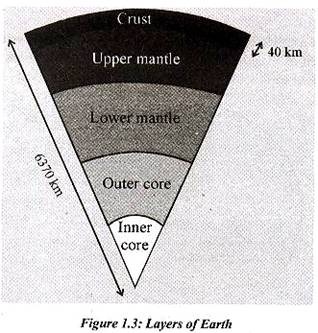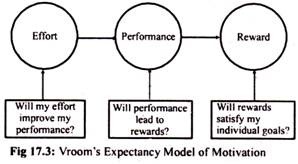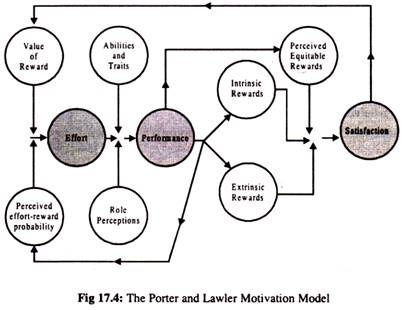Explain the theories of motivation.
These are discussed in brief in that order.
1. Maslow’s Need Hierarchy Theory:
It is probably safe to say that the most well-known theory of motivation is Maslow’s need hierarchy theory Maslow’s theory is based on the human needs. Drawing chiefly on his clinical experience, he classified all human needs into a hierarchical manner from the lower to the higher order.
In essence, he believed that once a given level of need is satisfied, it no longer serves to motivate man. Then, the next higher level of need has to be activated in order to motivate the man. Maslow identified five levels in his need hierarchy as shown in figure 17.2.
These are now discussed one by one:
1. Physiological Needs:
These needs are basic to human life and, hence, include food, clothing, shelter, air, water and necessities of life. These needs relate to the survival and maintenance of human life. They exert tremendous influence on human behaviour. These needs are to be met first at least partly before higher level needs emerge. Once physiological needs are satisfied, they no longer motivate the man.
2. Safety Needs:
After satisfying the physiological needs, the next needs felt are called safety and security needs. These needs find expression in such desires as economic security and protection from physical dangers. Meeting these needs requires more money and, hence, the individual is prompted to work more. Like physiological needs, these become inactive once they are satisfied.
3. Social Needs:
Man is a social being. He is, therefore, interested in social interaction, companionship, belongingness, etc. It is this socialising and belongingness why individuals prefer to work in groups and especially older people go to work.
4. Esteem Needs:
These needs refer to self-esteem and self-respect. They include such needs which indicate self-confidence, achievement, competence, knowledge and independence. The fulfillment of esteem needs leads to self-confidence, strength and capability of being useful in the organisation. However, inability to fulfill these needs results in feeling like inferiority, weakness and helplessness.
5. Self-Actualisation Needs:
This level represents the culmination of all the lower, intermediate, and higher needs of human beings. In other words, the final step under the need hierarchy model is the need for self-actualization. This refers to fulfillment.
The term self-actualization was coined by Kurt Goldstein and means to become actualized in what one is potentially good at. In effect, self- actualization is the person’s motivation to transform perception of self into reality.
According to Maslow, the human needs follow a definite sequence of domination. The second need does not arise until the first is reasonably satisfied, and the third need does not emerge until the first two needs have been reasonably satisfied and it goes on. The other side of the need hierarchy is that human needs are unlimited. However, Maslow’s need hierarchy-theory is not without its detractors.
The main criticisms of the theory include the following:
1. The needs may or may not follow a definite hierarchical order. So to say, there may be overlapping in need hierarchy. For example, even if safety need is not satisfied, the social need may emerge.
2. The need priority model may not apply at all times in all places.
3. Researches show that man’s behaviour at any time is mostly guided by multiplicity of behaviour. Hence, Maslow’s preposition that one need is satisfied at one time is also of doubtful validity.
4. In case of some people, the level of motivation may be permanently lower. For example, a person suffering from chronic unemployment may remain satisfied for the rest of his life if only he/she can get enough food.
2. Herzberg’s Motivation Hygiene Theory:
The psychologist Frederick Herzberg extended the work of Maslow and propsed a new motivation theory popularly known as Herzberg’s Motivation Hygiene (Two-Factor) Theory. Herzberg conducted a widely reported motivational study on 200 accountants and engineers employed by firms in and around Western Pennsylvania.
He asked these people to describe two important incidents at their jobs:
(1) When did you feel particularly good about your job, and
(2) When did you feel exceptionally bad about your job? He used the critical incident method of obtaining data.
The responses when analysed were found quite interesting and fairly consistent. The replies respondents gave when they felt good about their jobs were significantly different from the replies given when they felt bad. Reported good feelings were generally associated with job satisfaction, whereas bad feeling with job dissatisfaction. Herzberg labelled the job satisfiers motivators, and he called job dissatisfies hygiene or maintenance factors. Taken together, the motivators and hygiene factors have become known as Herzberg’s two-factor theory of motivation
Herzberg’s motivational and hygiene factors have been shown in the Table 17.1
According to Herzberg, the opposite of satisfaction is not dissatisfaction. The underlying reason, he says, is that removal of dissatisfying characteristics from a job does not necessarily make the job satisfying. He believes in the existence of a dual continuum. The opposite of ‘satisfaction’ is ‘no satisfaction’ and the opposite of ‘dissatisfaction’ is ‘no dissatisatisfaction’.
According to Herzberg, today’s motivators are tomorrow’s hygiene because the latter stop influencing the behaviour of persons when they get them. Accordingly, one’s hygiene may be the motivator of another.
However, Herzberg’s model is labeled with the following criticism also:
1. People generally tend to take credit themselves when things go well. They blame failure on the external environment.
2. The theory basically explains job satisfaction, not motivation.
3. Even job satisfaction is not measured on an overall basis. It is not unlikely that a person may dislike part of his/ her job, still thinks the job acceptable.
4. This theory neglects situational variable to motivate an individual.
Because of its ubiquitous nature, salary commonly shows up as a motivator as well as hygine.
Regardless of criticism, Herzberg’s ‘two-factor motivation theory’ has been widely read and a few managers seem untaminar with his recommendations. The main use of his recommendations lies in planning and controlling of employees work.
3. McClelland’s Need Theory:
Another well-known need-based theory of motivation, as opposed to hierarchy of needs of satisfaction-dissatisfaction, is the theory developed by McClelland and his associates’. McClelland developed his theory based on Henry Murray’s developed long list of motives and manifest needs used in his early studies of personality. McClelland’s need-theory is closely associated with learning theory, because he believed that needs are learned or acquired by the kinds of events people experienced in their environment and culture.
He found that people who acquire a particular need behave differently from those who do not have. His theory focuses on Murray’s three needs; achievement, power and affiliation. In the literature, these three needs are abbreviated “n Ach”, “n Pow”, and “n Aff” respectively’.
They are defined as follows:
Need for Achievement:
This is the drive to excel, to achieve in relation to a set of standard, and to strive to succeed. In other words, need for achievement is a behaviour directed toward competition with a standard of excellence. McClelland found that people with a high need for achievement perform better than those with a moderate or low need for achievement, and noted regional / national differences in achievement motivation.
Through his research, McClelland identified the following three characteristics of high-need achievers:
1. High-need achievers have a strong desire to assume personal responsibility for performing a task for finding a solution to a problem.
2. High-need achievers tend to set moderately difficult goals and take calculated risks.
3. High-need achievers have a strong desire for performance feedback.
Need for Power:
The need for power is concerned with making an impact on others, the desire to influence others, the urge to change people, and the desire to make a difference in life. People with a high need for power are people who like to be in control of people and events. This results in ultimate satisfaction to man.
Read more : eGyanKosh: Semester-I
Read more : HOW TO DOWNLOAD IGNOU STUDY MATERIAL ? – IGNOU Assignment Wala
People who have a high need for power are characterized by:
1. A desire to influence and direct somebody else.
2. A desire to exercise control over others.
3. A concern for maintaining leader-follower relations.
Need for Affiliation:
The need for affiliation is defined as a desire to establish and maintain friendly and warm relations with other people’. The need for affiliation, in many ways, is similar to Maslow’s social needs.
The people with high need for affiliation have these characteristics:
1. They have a strong desire for acceptance and approval from others.
2. They tend to conform to the wishes of those people whose friendship and companionship they value.
3. They value the feelings of others.
Figure 17.2 is a summary chart of the three need theories of motivation just discussed. The chart shows the parallel relationship between the needs in each of the theories. Maslow refers to higher- lower order needs, whereas Herzberg refers to motivation and hygiene factors.
4. McGregor’s Participation Theory:
Douglas McGregor formulated two distinct views of human being based on participation of workers. The first basically negative, labeled Theory X, and the other basically positive, labled Theory Y.
Theory X is based on the following assumptions:
1. People are by nature indolent. That is, they like to work as little as possible.
2. People lack ambition, dislike responsibility, and prefer to be directed by others.
3. People are inherently self-centered and indifferent to organisational needs and goals.
4. People are generally gullible and not very sharp and bright.
On the contrary, Theory Y assumes that:
1. People are not by nature passive or resistant to organisational goals.
2. They want to assume responsibility.
3. They want their organisation to succeed.
4. People are capable of directing their own behaviour.
5. They have need for achievement.
What McGregor tried to dramatise through his theory X and Y is to outline the extremes to draw the fencing within which the organisational man is usually seen to behave. The fact remains that no organisational man would actually belong either to theory X or theory Y. In reality, he/she shares the traits of both. What actually happens is that man swings from one set or properties to the other with changes in his mood and motives in changing .environment.
5. Urwick’s Theory Z:
Much after the propositions of theories X and Y by McGregor, the three theorists Urwick, Rangnekar, and Ouchi-propounded the third theory lebeled as Z theory.
The two propositions in Urwicks’s theory are that:
(i) Each individual should know the organisational goals precisely and the amount of contribution through his efforts towards these goals.
(ii) Each individual should also know that the relation of organisational goals is going to satisfy his/her needs positively.
In Urwick’s view, the above two make people ready to behave positively to accomplish both organisational and individual goals.
However, Ouchi’s Theory Z has attracted the lot of attention of management practitioners as well as researchers. It must be noted that Z does not stand for anything, is merely the last alphabet in the English Language.
Theory Z is based on the following four postulates:
1. Strong Bond between Organisation and Employees
2. Employee Participation and Involvement
3. No Formal Organisation Structure
4. Human Resource Development
Ouchi’s Theory Z represents the adoption of Japanese management practices (group decision making, social cohesion, job security, holistic concern for employees, etc.)by the American companies. In India, Maruti-Suzuki, Hero-Honda, etc., apply the postulates of theory Z.
6. Argyris’s Theory:
Argyris has developed his motivation theory based on proposition how management practices affect the individual behaviour and growth In his view, the seven changes taking place in an individual personality make him/her a mature one. In other words, personality of individual develops
Argyris views that immaturity exists in individuals mainly because of organisational setting and management practices such as task specialisation, chain of command, unity of direction, and span of management. In order to make individuals grow mature, he proposes gradual shift from the existing pyramidal organisation structure to humanistic system; from existing management system to the more flexible and participative management.
He states that such situation will satisfy not only their physiological and safety needs, but also will motivate them to make ready to make more use of their physiological and safety needs. But also will motivate them to make ready to make more use of their potential in accomplishing organisational goals.
7. Vroom’s Expectancy Theory:
One of the most widely accepted explanations of motivation is offered by Victor Vroom in his Expectancy Theory” It is a cognitive process theory of motivation. The theory is founded on the basic notions that people will be motivated to exert a high level of effort when they believe there are relationships between the effort they put forth, the performance they achieve, and the outcomes/ rewards they receive.
The relationships between notions of effort, performance, and reward are depicted in Figure 17.3
Thus, the key constructs in the expectancy theory of motivation are:
1. Valence:
Valence, according to Vroom, means the value or strength one places on a particular outcome or reward.
2. Expectancy:
It relates efforts to performance.
3. Instrumentality:
By instrumentality, Vroom means, the belief that performance is related to rewards.
Thus, Vroom’s motivation can also be expressed in the form of an equation as follows: Motivation = Valence x Expectancy x Instrumentality
Being the model multiplicative in nature, all the three variables must have high positive values to imply motivated performance choice. If any one of the variables approaches to zero level, the possibility of the so motivated performance also touches zero level.
However, Vroom’s expectancy theory has its critics. The important ones are:
1. Critics like Porter and Lawler lebeled it as a theory of cognitive hedonism which proposes that individual cognitively chooses the course of action that leads to the greatest degree of pleasure or the smallest degree of pain.
2. The assumption that people are rational and calculating makes the theory idealistic.
3. The expectancy theory does not describe individual and situational differences.
But the valence or value people place on various rewards varies. For example, one employee prefers salary to benefits, whereas another person prefers to just the reverse. The valence for the same reward varies from situation to situation.
In spite of all these critics, the greatest point in me expectancy theory is that it explains why significant segment of workforce exerts low levels of efforts in carrying out job responsibilities.
8. Porter and Lawler’s Expectancy Theory:
In fact, Porter and Lawler’s theory is an improvement over Vroom’s expectancy theory. They posit that motivation does not equal satisfaction or performance. The model suggested by them encounters some of the simplistic traditional assumptions made about the positive relationship between satisfaction and performance. They proposed a multi-variate model to explain the complex relationship that exists between satisfaction and performance.
What is the main point in Porter and Lawler’s model is that effort or motivation does not lead directly to performance. It is intact, mediated by abilities and traits and by role perceptions. Ultimately, performance leads to satisfaction,. The same is depicted in the following Fig 17.4.
There are three main elements in this model. Let us briefly discuss these one by one.
Effort:
Effort refers to the amount of energy an employee exerts on a given task. How much effort an employee will put in a task is determined by two factors-
(i) Value of reward and
(ii) Perception of effort-reward probability.
Performance:
One’s effort leads to his/her performance. Both may be equal or may not be. However the amount of performance is determined by the amount of labour and the ability and role perception of the employee. Thus, if an employee possesses less ability and/or makes wrong role perception, his/her performance may be low in spite of his putting in great efforts.
Satisfaction:
Performance leads to satisfaction. The level of satisfaction depends upon the amount of rewards one achieves. If the amount of actual rewards meet or exceed perceived equitable rewards, the employee will feel satisfied. On the country, if actual rewards fall short of perceived ones, he/she will be dissatisfied.
Rewards may be of two kinds—intrinsic and extrinsic rewards. Examples of intrinsic rewards are such as sense of accomplishment and self-actualisation. As regards extrinsic rewards, these may include working conditions and status. A fair degree of research support that, the intrinsic rewards are much more likely to produce attitudes about satisfaction that are related to performance.
There is no denying of the fact that the motivation model proposed by Porter and Lawler is quite complex than other models of motivation. In fact motivation itself is not a simple cause-effect relationship rather it is a complex phenomenon Porter and Lawler have attempted to measure variables such as the values of possible rewards, the perception of effort-rewards probabilities and role perceptions in deriving satisfaction.
They recommended that the managers should carefully reassess their reward system and structure. The effort-performance-reward-satisfaction should be made integral to the entire system of managing men in organisation.











